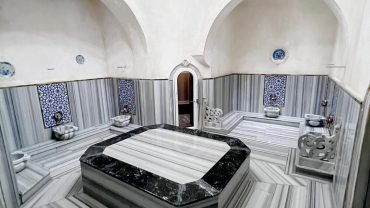Turkish Delight and Sweets
Istanbul is a treasure trove for aficionados of Turkish delight, or lokum, and other traditional sweets. Turkish delight has a rich history dating back to the Ottoman Empire, where it was originally crafted as a luxurious treat for sultans and their courts. This gelatinous, sugar-dusted confection comes in various flavors, such as rose, lemon, and pomegranate, often enhanced with nuts like pistachios and hazelnuts. The cultural significance of Turkish delight extends beyond its taste, embodying the hospitality and culinary artistry of Turkish culture.
The Spice Bazaar, also known as the Egyptian Bazaar, is a prime destination for those wondering what is famous in Istanbul to buy. Here, one can find an array of Turkish delights in vibrant displays. Another iconic establishment is Hafiz Mustafa, a historic confectionery that has been perfecting the art of Turkish sweets since 1864. Their offerings range from classic Turkish delight to innovative modern variations, all made with the finest ingredients.
Beyond Turkish delight, Istanbul boasts an array of other delectable sweets. Baklava, with its layers of filo pastry, honey, and nuts, is a perennial favorite. Halva, a dense, sesame-based confection, and pishmaniye, a candy floss-like treat, also hold special places in Turkish culinary tradition. Each of these sweets offers a unique taste experience, reflecting the diverse influences that have shaped Turkish cuisine over centuries.
When purchasing these delicacies, consider a few key tips to ensure the best flavor and longevity. Freshness is paramount; always opt for shops known for high turnover to ensure your sweets are recently made. Store Turkish delights in an airtight container at room temperature to maintain their texture. Baklava should be kept in a cool, dry place to prevent it from becoming soggy. For halva and pishmaniye, a cool, dark storage environment is ideal to preserve their distinct textures.
Thus, whether you are a local or a visitor, exploring the famous sweets of Istanbul offers a delightful journey into the city’s rich culinary history and vibrant culture.
Handwoven Carpets and Kilims
Istanbul stands as a premier destination for acquiring handwoven carpets and kilims, revered globally for their extraordinary craftsmanship and detailed designs. The tradition of carpet weaving in Turkey dates back centuries, with each piece reflecting the rich cultural tapestry and historical influences of the region. Turkish carpets, known for their fine knots and robust construction, differ from kilims, which are flat-woven and characterized by their geometric patterns.
The distinction between carpets and kilims is crucial for any prospective buyer. While carpets are often thicker and more intricate, kilims offer a lighter, more flexible alternative, often used as wall hangings or floor coverings. Regions such as Anatolia, Hereke, and Konya are renowned for their unique styles, each bringing a distinct touch to the art of weaving. For instance, Hereke carpets are celebrated for their silk compositions and elaborate patterns, making them a prized possession.
When in Istanbul, the Grand Bazaar is an essential stop for anyone looking to purchase these exquisite textiles. This historic market is home to a multitude of reputable carpet shops such as Şişko Osman and Dhoku, where authenticity and quality are paramount. In addition to the Grand Bazaar, the Arasta Bazaar offers a more intimate shopping experience with a selection of high-quality carpets and kilims.
Assessing the quality and authenticity of these textiles requires attention to detail. Look for tight, even knots, vibrant natural dyes, and symmetrical patterns. Reputable sellers will often provide certificates of authenticity and detailed information about the carpet’s origin and materials.
Bargaining is a customary practice in Istanbul’s markets. Approach it with respect and politeness, as it is seen as a form of cultural exchange. Once a purchase is made, transporting these treasures home can be straightforward; many shops offer shipping services, ensuring that your handwoven carpet or kilim arrives safely at your doorstep.
Turkish Ceramics and Iznik Pottery
Turkish ceramics, especially Iznik pottery, hold a revered place in the rich tapestry of Istanbul’s artisanal heritage. Known for their vibrant colors and intricate patterns, these ceramics have captivated art enthusiasts and collectors worldwide. The history of Turkish ceramics dates back to the early Ottoman period, with Iznik pottery emerging as a prominent art form in the 15th and 16th centuries. Named after the town of Iznik, these ceramics are renowned for their distinctive blue and white motifs, which later expanded to include a broader palette of colors.
Iznik pottery encompasses a wide range of items, including tiles, plates, bowls, and vases. Each piece is meticulously crafted, often featuring floral and geometric designs that reflect the Ottoman aesthetic. The tiles, in particular, have been used extensively in the decoration of mosques, palaces, and public buildings, making them a significant part of Turkish architectural heritage.
When exploring what is famous in Istanbul to buy, authentic Turkish ceramics are a must-have. The Grand Bazaar and Arasta Bazaar are two prime locations where you can find high-quality pieces. The Grand Bazaar, one of the oldest and largest covered markets in the world, houses numerous shops specializing in ceramics. Artisans in these shops continue the traditional methods of pottery making, ensuring each item is unique. Similarly, the Arasta Bazaar, located near the Blue Mosque, offers a more intimate shopping experience with a focus on handcrafted goods.
Distinguishing high-quality ceramics from mass-produced ones requires a keen eye. Authentic Iznik pottery is typically hand-painted with natural mineral pigments, resulting in vibrant colors that do not easily fade. The glaze should be smooth and even, with no visible brush strokes or imperfections. Additionally, genuine pieces often bear the signature or mark of the artisan, adding to their authenticity and value.
For those interested in the finest examples of Turkish ceramics, visiting noted shops and artisan studios is essential. These include Iznik Classics and Firca Ceramics in the Grand Bazaar, as well as the workshops in the Arasta Bazaar. By purchasing from these reputable sources, you not only acquire a beautiful piece of art but also support the continuation of this cherished craft.
Traditional Turkish Textiles and Clothing
Istanbul is renowned for its vibrant tapestry of traditional textiles and clothing, which embody the rich cultural heritage of Turkey. One of the most sought-after items is the silk scarf, known for its luxurious feel and intricate patterns. These scarves, often adorned with motifs reflective of Turkish art and history, make for exquisite souvenirs. Similarly, embroidered fabrics, including the stunning suzani, capture the essence of Istanbul’s craftsmanship. Suzani, a type of embroidered textile, typically features elaborate designs with symbolic meanings, making it a unique piece of art.
The traditional Turkish kaftan, a long, flowing garment, is another iconic clothing item. Historically worn by Ottoman sultans, modern renditions of kaftans maintain their regal charm while incorporating contemporary fashion elements. Peshtemals, or Turkish towels, are yet another distinctive item. Originally used in Turkish baths, these lightweight, absorbent, and quick-drying towels have found their way into modern homes and spas around the world.
For those wondering where to buy these traditional textiles and clothing in Istanbul, the city’s bustling markets and specialized boutiques offer a plethora of options. The Grand Bazaar, one of the largest and oldest covered markets globally, is a treasure trove for anyone seeking authentic Turkish textiles. Here, visitors can find everything from hand-woven carpets to finely embroidered fabrics. The Arasta Bazaar, located near the Blue Mosque, is another excellent spot for high-quality textiles and traditional attire.
When shopping, it’s essential to recognize quality craftsmanship. Authentic Turkish textiles are often hand-made with meticulous attention to detail. Look for vibrant colors, intricate patterns, and fine stitching, which are hallmarks of genuine pieces. Additionally, consider visiting boutiques that showcase modern Turkish fashion designers who blend traditional elements with contemporary styles. Designers such as Arzu Kaprol and Bora Aksu are celebrated for their innovative approach to integrating Turkey’s rich textile heritage into modern fashion, offering a fresh take on traditional Turkish clothing.





Comment (0)